Transition from Minecraft to the Sandbox
Playing Minecraft and the Sandbox game is surprisingly similar. Minecraft is all about “placing blocks and having adventures.” Furthermore, it’s “a creative space to build almost anything you can imagine.
These same principles apply to the Sandbox. It’s a game designed for adventures and creation. However, unlike Minecraft, Sandbox adds the layer of P2E (Play to Earn).
Let’s start by outlining Minecraft.
The Minecraft Health Bar
- The way to survival in Minecraft is a steady food supply and staying safe from monsters. If your health drops to zero, your game is over.
If you build a sufficient shelter, the monsters won’t be able to get in. Further on in the game, you will be able to make doors, windows, etc. In Minecraft, most monsters will come out at night.
How About Building?
The most significant similarity between the Sandbox and Minecraft is the building abilities. In Minecraft, you start by collecting some trees. You’ll need more powerful tools than just fists to break down certain blocks. But the basics of Minecraft are, breaking a block, picking it up, then placing it somewhere else to build.
Once you’ve broken down a tree, you can check your inventory screen. Here you’ll find everything that you’ve collected. Drag some of those materials into your crafting space, and they’ll appear. Inside your crafting space, you combine materials you’ve collected to make more complex objects. Drag them back into your inventory, and they’re all yours.
The process described above is what’s called Crafting. It’s one of the most basic and intrinsic parts of playing the game.
Now, let’s take a look at Creative Mode within Minecraft. In this game mode, you cannot die—no need to worry about survival, just creativity.
Once in this game mode, you’ll be able to explore endlessly, you won’t get tired, and your pickaxe can forever collect, but be careful not to fall.
Now we’re able to translate these skills into the Sandbox.
Let’s first look at “Sandbox.” A Sandbox concerning gaming means that there are no set objects. This means that you have all the space for creativity. Players each create their path in the game.
Sandbox is a platform available to anyone to create their world. Unlike Minecraft, you’ll be able to build without first collecting. By default, the same basic materials are accessible to all creators.
On top of that, you can add in complex (no codding required) game mechanics. For example, if the player defeats this monster A, open door B.
Comparing Sandbox and Minecraft
Both offer:
- Extendable abstract game
- Player customization
- Creator ecosystem
- A large community
Minecraft exceeds:
- Microsoft suite
- Mincraft200.0
Sandbox exceeds:
- High dollar market cap
- Low resource gameplay
- NFTs
- Building games inside the game
- Plugins
- Social Profiles
Let’s expand some of the main Sandbox advantages.
NFTs
Instead of trading time for items that only exist in one place, how about spending your time on an item that can be transferred for value. Not just to another person, but to another game as well. NFTs are items that feature unique ownership through on-chain contracts. As a player, you can “craft” things that exist; in your world and game, the entire Sandbox universe, and the broader blockchain ecosystem.
An NFT is a unique proof of ownership. As a gamer, imagine trading your time for a piece of value.
Within the Sandbox, to have the freedom to host your world, you must first own a piece of land in the form of an NFT.
LAND
The main point of entry into the Sandbox game is owning a piece of land. These digital plots are squares that are NFTs. Wallet addresses control what experience or game appears on them. It’s possible to combine multiple pieces of land to create an estate. Furthermore, many landowners can join together and create districts that have their own set of governing rules and regulations.
A single piece of LAND is 96×96 meters and can feel quite large. The Minecraft world is 60,000 kilometers squared (bigger than Neptune).
The simple idea behind a piece of land is content creation and ownership. Instead of spending countless hours in your Neptune-sized world creating endlessly, why not do it in the Sandbox. Any asset created is interoperable with other pieces of LAND and can be bought, sold, or traded.
We should mention that you don’t need to own a piece of LAND to be a creator. Anyone can download the Game Maker and start building. LAND owners will pay top dollar for skilled game builders in the future.
According to the Sandbox white paper, it is a “unique virtual world where players can build, own and monetize their gaming experiences using SAND…”.
In Game Economics
Participants are rewarded with the SAND token by partaking in the ecosystem and can use it to trade for real-world value.
You can also use SAND to play other games, buy equipment, or customize your avatar. There is also the opportunity to earn SAND by playing games.
Governance is another primary use case for the SAND token. By participating in a DAO structure, SAND holders can vote on decisions for the platform.
If you aren’t interested in building, playing, or voting but still want exposure to the growth of the overall ecosystem, it’s possible to stake your tokens. Staking is a mechanism where liquidity providers (stakers) earn revenue annually. 2.5% of transaction fees gathered from the entire ecosystem get allocated to staking rewards. At the time of writing, rewards are 60% annually.
Sandbox History
Sandbox is also a traditional game. It first launched in 2012 on IOS and Android. Fundamentally, it was very similar to the idea of user-generated content. They have had over 40,0000,000 download their software and create a new world.
Transitioning from Minecraft to the Sandbox
Many open-world “sandbox” games exist, whether Minecraft, Roblox, or many other platforms. Sandbox’s main value proposition is making money to play or build video games.
Some traditional players may not be super interested in this idea. They play for the fun of it. However, after spending thousands of hours and countless dollars on skins, what do they have to show for it? With the Sandbox in-game economy, players can trade their time and in-game value for real-world currency.
With this new model, you can imagine children paying for their college education just by playing video games.
Written by Tyler Monette
Follow me on Twitter!


